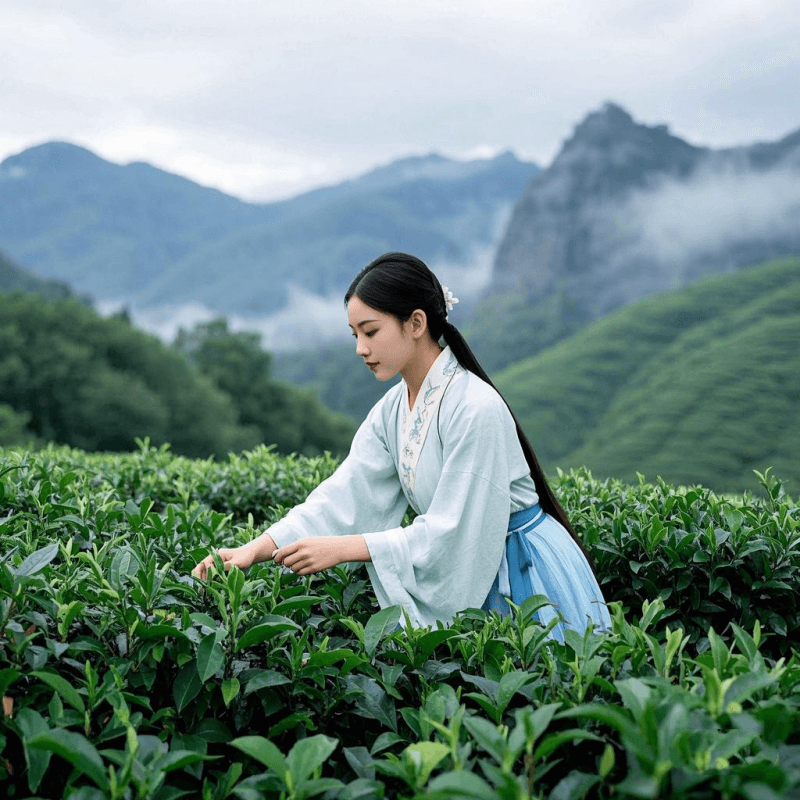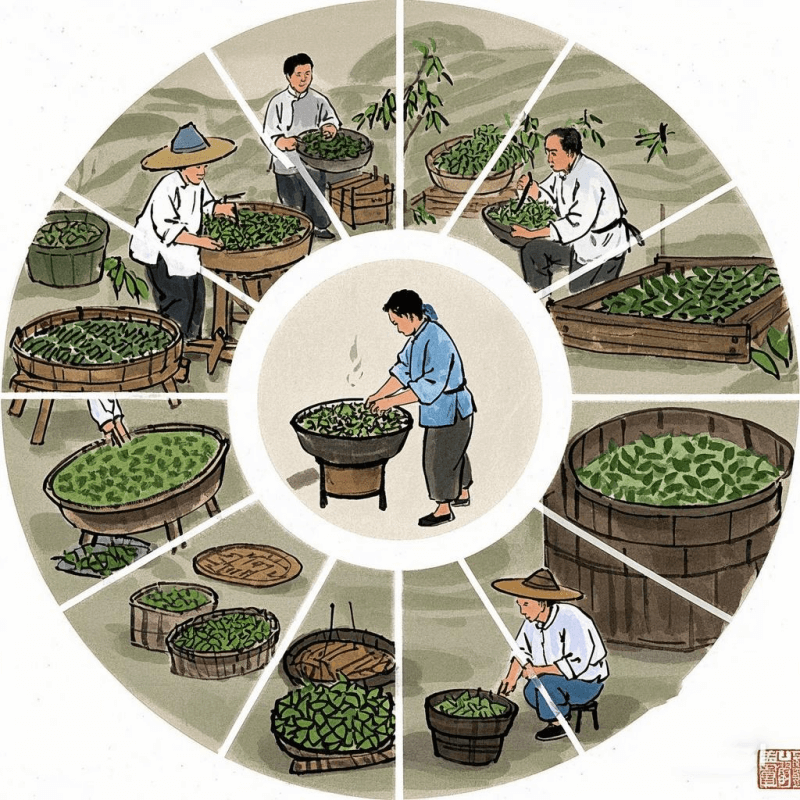1. Introduction: Why Oolong Tea Chinese History Still Fascinates Tea Lovers

For centuries, oolong tea has been more than a beverage in China—it’s a cultural artifact, a symbol of craftsmanship, and a bridge between tradition and innovation. The question isn’t just how this tea evolved, but why its Chinese roots continue to shape global tea culture today. From royal courts to modern cafes, oolong tea chinese varieties tell stories of mountains, monks, and master tea makers who turned leaves into liquid art.
What makes this history so compelling? It’s the blend of accident and intention: oolong’s creation was likely a happy mistake (legend says a farmer forgot his tea leaves, letting them oxidize), but its survival depended on generations perfecting the process. Today, as more people seek authentic food experiences, exploring oolong tea’s Chinese heritage offers a taste of history in every sip.
2. The Origins: Tracing the History of Oolong Tea in China
The story of oolong tea begins in China’s misty mountains, where oral traditions and ancient texts hint at its birth.
🏯 Legends and Early Records
One of the most enduring tales dates to the Ming Dynasty (1368–1644), set in Fujian Province’s Wuyi Mountains. A tea farmer named Su was distracted by a deer while drying his harvest; when he returned, his leaves had wilted and turned reddish. Reluctant to waste them, he processed them anyway—and discovered a richer, smoother tea. This “accident” is said to be the first oolong tea chinese variety.
Historical records confirm that by the 17th century, oolong was a staple in imperial courts. The Compendium of Materia Medica (1593) mentions a “semi-oxidized tea” from Fujian, prized for its balance of green tea’s freshness and black tea’s depth.
🌍 Spread Beyond Borders
By the 19th century, Chinese oolong reached Taiwan (then under Qing rule), where high-altitude climates transformed it into new varieties. Later, traders introduced it to Europe and America, where it became known as “black dragon tea” (a translation of “wulong,” or oolong). Yet its soul remained rooted in Chinese techniques—proof that oolong tea’s identity is inseparable from its homeland.
3. Signature Styles of Chinese Oolong Tea
Oolong tea chinese varieties are defined by their processing, which balances oxidation (10–80%) and roasting. Here are the most iconic styles:
🍂 Lightly Oxidized Oolong
- Tie Guan Yin (Iron Goddess of Mercy): Hailing from Anxi, Fujian, this tea undergoes 10–20% oxidation. Its leaves are tightly rolled into (small balls) that unfurl when steeped, releasing jasmine and orchid aromas. Traditionally, it’s roasted lightly, though modern versions often skip roasting for brighter flavor.
- Bai Hao Oolong: Also from Fujian, this rare tea uses buds covered in fine white hairs, oxidized 20–30% to preserve a creamy, honeyed taste.
🔥 Heavily Oxidized and Roasted Oolong
- Da Hong Pao (Big Red Robe): A Wuyi Mountain legend, this oolong is oxidized 60–80% and roasted over pine wood, developing notes of caramel, leather, and mineral. It’s so prized that a single gram once sold for $1,000 at auction.
- Shui Xian (Narcissus): Named for its floral aroma, this Fujian variety is oxidized 40–60% and roasted to bring out earthy, woody undertones. It ages beautifully, with 10-year-old versions fetching premium prices.
Each style reflects a philosophy: light oolongs celebrate delicacy, while dark ones honor depth—a duality that makes oolong tea endlessly fascinating.

4. Regional Varieties: From Fujian to Guangdong and Taiwan
China’s diverse landscapes breed distinct oolong personalities. Here’s how geography shapes flavor:
🏔️ Fujian Province: The Cradle of Oolong
- Wuyi Mountains: Rugged terrain and mineral-rich soil give teas like Da Hong Pao their “rock rhyme” (yan yun)—a distinctive minerality. Farmers here use traditional stone drying rooms to enhance this quality.
- Anxi County: Known as “Tie Guan Yin hometown,” its fertile valleys and humid climate produce oolongs with intense floral notes. The region’s tea markets, open since the 18th century, remain hubs for oolong tea chinese trade.
🌿 Guangdong Province: A Hidden Gem
Guangdong’s Phoenix Mountains (Fenghuangshan) are home to “Phoenix Oolong,” made from wild tea trees (some over 1,000 years old). These trees absorb the region’s subtropical warmth, creating teas with apricot, honey, and a hint of smoke. Locals often brew it in small clay pots to concentrate its flavor.
🏞️ Taiwan: Innovation Meets Tradition
While Taiwan is politically separate, its oolong heritage is deeply Chinese. Introduced in the 18th century, Taiwanese varieties like Alishan and Dongding thrive at 1,000+ meter elevations. Cool mountain air slows growth, resulting in buttery, milky oolongs—lighter than Fujian’s, but still rooted in oolong tea chinese processing methods.
As TeaClass.com notes, “Every mountain range, every valley, gives oolong a unique fingerprint—no two regions taste quite the same.”
5. Traditional Production Methods That Define Oolong Tea Chinese Identity
What sets oolong tea chinese varieties apart is their labor-intensive, hands-on processing. These steps, honed over centuries, are as much art as science:
👨🌾 Plucking: Timing Is Everything
Harvesters select leaves in the “two leaves and a bud” formation, usually in spring (March–April) or autumn (September–October). Spring yields are prized for their tenderness, while autumn brings richer flavors. In Wuyi, some teas are plucked only once every three years to let bushes recover.
🍃 Withering and Oxidation: The Heart of Oolong
Leaves are spread on bamboo mats to wilt, then gently rolled to bruise cell walls—triggering oxidation. For light oolongs, this stops after 2–3 hours; for dark ones, it continues for 6–8 hours. Master tea makers judge readiness by sight (leaves turn reddish at the edges) and smell (a sweet, fruity aroma).
🔥 Fixing and Roasting: Locking in Flavor
“Fixing” (pan-frying) halts oxidation, preserving the tea’s character. Roasting (for dark oolongs) is done over low heat, often using pine or bamboo wood to infuse smoky notes. This step requires patience—over-roasting burns the leaves, while under-roasting leaves them flat.
✂️ Shaping: Beauty in Every Leaf
Leaves are rolled into tight balls (Tie Guan Yin), twisted strips (Da Hong Pao), or natural shapes (Phoenix Oolong). This isn’t just for aesthetics: shape affects how the tea brews, with tighter rolls releasing flavor more slowly.
6. How the Global Market Is Embracing Chinese Oolong Tea Today
Once a niche import, oolong tea is now a global sensation—thanks in part to its Chinese heritage.
☕ Cafes and Home Brewing
Brands like Starbucks and %Arabica now offer oolong lattes, while home brewers seek authentic varieties online. A 2023 survey by the World Tea Association found that 38% of U.S. tea drinkers have tried oolong tea chinese varieties, citing “unique flavor” as the top reason.
🌱 Sustainability and Fair Trade
Young Chinese tea makers are blending tradition with eco-conscious practices: organic farming, solar drying, and direct trade with global buyers. This not only preserves heritage but ensures fair wages for farmers—a win for both culture and communities.
🎓 Education and Appreciation
Tea schools in Fujian and Taiwan now teach oolong tea craftsmanship to international students, spreading knowledge of its history. Workshops on gongfu tea (a ceremonial way to brew oolong) are popular in cities like New York and London, letting people connect with its cultural roots.
7. Conclusion: Preserve the Legacy of Chinese Oolong Tea Culture
Oolong tea chinese history is a story of passion—farmers (guarding) ancient techniques, innovators reimagining possibilities, and drinkers savoring every nuance. From Wuyi’s rocky cliffs to Taiwan’s misty peaks, each variety carries the spirit of its land and people.
To truly appreciate oolong, we must honor its past while embracing its future. Explore authentic oolong tea from China’s most famous mountains to taste this legacy for yourself. Whether you prefer a floral Tie Guan Yin or a roasted Da Hong Pao, remember: every sip is a link to centuries of tradition.
In a fast-paced world, oolong tea invites us to slow down—to steep, savor, and reflect on the beauty of something crafted with care. That’s the magic of Chinese oolong: it’s not just tea—it’s history in a cup.
Discover the rich history of oolong tea chinese styles and regional varieties. Explore how China’s heritage shapes every sip of authentic oolong tea—click to learn more!
